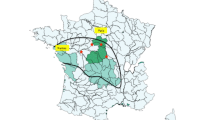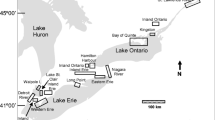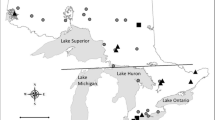Abstract
Comparison of organochlorine residues in wildlife must often be made to regulatory standards or to values of known biological significance; this is difficult when dissimilar tissues are analyzed and results are expressed on different bases. To relate levels in the different tissues used for regulatory and monitoring purposes and for biological assessments, we exposed American black ducks to mixtures of three organochlorines. Differences in residue burdens among tissues were not statistically significant when levels were expressed on a lipid weight basis. Levels of heptachlor and Aroclor 1254 in one tissue can be accurately predicted from those in another; such predictions for endrin are less reliable. Lipid weight based residue concentrations in wings may be used to predict whether levels in fat exceed residue standards set for human health or approach those associated with effects on populations of species sampled.
Similar content being viewed by others
References
Blus, L. J., Henny, C. J., Lenhart, D. J., and Kaiser, T. E.: 1984, ‘Effects of Heptachlor and Lindane-Treated Seed on Canada Geese’, J. Wildl. Manage. 48, 1097–1111.
Clark, D. R.Jr. and McLane, M. A. R.: 1974, ‘Chlorinated Hydrocarbon and Mercury Residues in Woodcock in the United States, 1971–71’, Pestic. Monit. J. 8, 15–22.
Cromartie, E., Reichel, W. L., Locke, L. N., Belisle, A. A., Kaiser, T. E., Lamont, T. G., Mulhern, B. M., Prouty, R. N., and Swineford, D. M.: 1975, ‘Residues of Organochlorine Pesticide and Polychlorinated Biphenyls and Autopsy Data for Bald Eagles, 1971 and 1972, Pestic. Monit. J. 9, 11–14.
Dindal, D. L. and Peterle, T. J.: 1968, ‘Wing and Body Tissue Realtionships of DDT and Metabolite Residues in Mallard and Lesser Scaup Ducks’, Bull. Environ. Contam. Toxicol. 3, 37–48.
Eisler, R.: 1986, P‘Polychlorinated Biphenyl Hazards to Fish, Wildlife, and Invertebrates: a Synoptic Review’, U.S. Fish Wild. Serv. Biol. Rep. 85(1.7), 72 pp.
Fleming, W. J., Mclane, M. A. R., and Cromartie, E.: 1982, ‘Endrin Decreases Screech Owl Productivity’, J. Wildl. Manage. 46, 462–468.
Henny, C. J., Blus, L. J., and Stafford, C. J.: 1983, ‘Effects of Heptachlor on American Kestrels in the Columbia Basin, Oregon’, J. Wildl. Manage. 47, 1080–1087.
Prouty, R. M. and Bunck, C. M.: 1986, ‘Organochlorine Residues in Adult Mallard and Black Duck Wings, 1981–1982’, Environ. Monit. Assessment 6, 49–57.
Roylance, K. J., Jorgensen, C. D., Booth, G. M., and Carter, M. W.: 1985, ‘Effects of Dietary Endrin on Reproduction of Mallard Ducks (Anas plathyrhynchos)’, Arch. Environ. Contam. Toxicol. 14, 705–711.
Schladweiler, P. and Weigand, J. P.: 1983, ‘Relationships of Endrin and Other Chlorinated Hydrocarbon Compounds to Wildlife in Montana, 1981–1982’, Wildlife Division, Montana Department of Fish, Wildlife, and Parks, Helena, xiii + 230 pp.
Spann, J. W., Heinz, G. H., and Hulse, C. S.: 1986, ‘Reproduction and Health in Mallards Fed Endrin’, Environ. Toxicol. Chem. 5, 755–759.
Stickel, L. F.: 1973, in C. A. Edwards (ed.), ‘Pesticide Residues in Birds and Mammals’, Environmental Pollution by Pesticides, Plenum Press, London and New York, pp. 254–312.
Wiemeyer, S. N., Porter, R. D., Hensler, G. L., and Maestrelli, J. R.: 1986, ‘DDE, DDT+Dieldrin: Residues in American Kestrels and Relations to Reproduction’, U.S. Fish Wildl. Serv., Fish Wildl. Tech. Rep. 6, 33.
Author information
Authors and Affiliations
Rights and permissions
About this article
Cite this article
Hall, R.J., Haseltine, S.D. & Geissler, P.H. Monitoring contaminant exposure: Relative concentrations of organochlorines in three tissues of American black ducks. Environ Monit Assess 13, 11–19 (1989). https://doi.org/10.1007/BF00398732
Issue Date:
DOI: https://doi.org/10.1007/BF00398732




